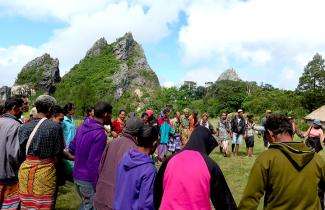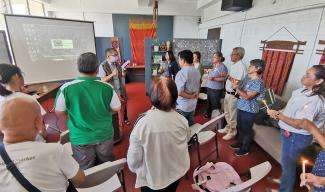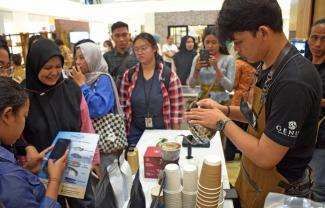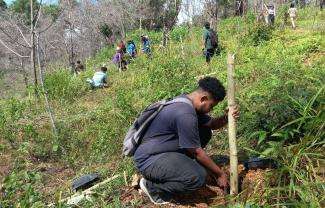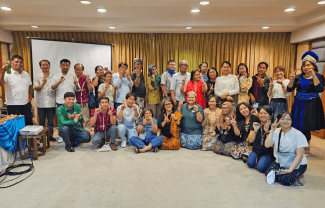The Nekafmese Tafena to Halat Festival, or Nekafmese Festival for short, was held in Nausus, North Molo, South Timor Tengah District, East Nusa Tenggara on June 19-24, 2014. The festival was held on Mutis peak, the highest summit of Timor Island. This is the fourth time that festival has been held, and this year's theme is Restoring the Bond with Nature to Face Crisis and Fight for Economic Independence. The event involved the Molo, Amanatun, and Amanuban people from South Timor Tengah District who are known as Tiga Batu Tungku (three hearth stones).
The Nekafmese Festival is held to fight against forgetting the struggle of the Tiga Batu Tungku against marble quarries proposing to destroy the mountain, a sacred site for traditional rites, the heart of the historical identity of the Tiga Batu Tungku indigenous community, as well as a vital water source. This festival celebrates the strength of the Molo, Amanatun, and Amanuban people, who peacefully and successfully shut down potential operators in 1996.
The festival begins with a non pah (back to nature) ritual. A procession by torchlight leaves from three locations in Bonleu/Tune, Fatumnasin, and Amanatun-Amanuban to meet in Nausus, passing historical sites where the communities fought against the quarries. The festival is a process to reflect on their fight, contemplate steps taken that need correction, and rethink ways to improve their relationship with nature.
During the festival, all members of the community help with planting, working together to clean and prepare the sites, and preparing food. A discussion is held to discuss weaving with the use of natural dyes, planting natural dye-producing plants, increasing product quality, and building weaver organization (from producing raw materials to marketing). Weaving is central to community culture, and this program is facilitated by Lawe and theGlobal Environment Facility - Small Grant Program (GEF-SGP) through their Weaving for Life program. A woven cloth exhibition and sale was also held during the festival, involving 57 weaver groups. In addition, a weaving competition was held for 8-12 year olds.
Discussion to strengthen local food to revitalize umebubu or granary, organic farming, livestock farming development, and biogas was facilitated by Ataimamus Organization (OAT) and Perkumpulan Pikul.
This festival was supported by the Mining Advocacy Network (JATAM), Indonesian Forum for Environment (WALHI) East Nusa Tenggara Chapter, and Indonesia Civil Society Forum for Climate Justice (CSF - CIJ).
The Molo area is very important to the hydrology of the Mutis region all the way to the downstream region. This area includes Mollo, Dili, and the entire Timor Island. Mutis is the source of four major rivers: Noebesi, Noe Pune, Noe Sasi, and Noe Noni rivers. These waters provide the Timor people with drinking water. The West Timor people express this interconnectedness concretely. In the words of Mama Aleta, the Goldman Prize recipient,
Soil is like flesh, trees are like hair, stones like bones, and water like blood.
